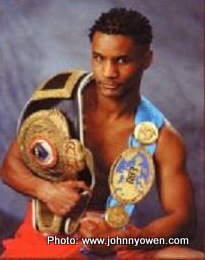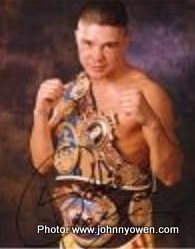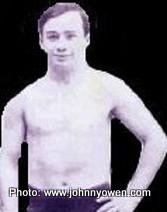 by Pavel Yakovlev – This summer, the World Boxing Council will hold its “Night of Champions 2010” event in Cardiff, Wales. The WBC’s selection of Wales as the host country draws attention to the long and rich history of Welsh boxing. In connection with the upcoming Cardiff event, ESB will celebrate Welsh boxing history by exploring the careers of prominent Welsh fighters of the past and present. In this feature, ESB focuses on Tommy Farr, Steve Robinson, Robbie Regan, and Percy Jones.
by Pavel Yakovlev – This summer, the World Boxing Council will hold its “Night of Champions 2010” event in Cardiff, Wales. The WBC’s selection of Wales as the host country draws attention to the long and rich history of Welsh boxing. In connection with the upcoming Cardiff event, ESB will celebrate Welsh boxing history by exploring the careers of prominent Welsh fighters of the past and present. In this feature, ESB focuses on Tommy Farr, Steve Robinson, Robbie Regan, and Percy Jones.
TOMMY FARR
British and British Heavyweight Champion, 1930s
Tommy Farr was born in Blaenclydach in 1913. Known as the “The Tonypandy Terror”, Farr is regarded as the greatest Welsh heavyweight in history, and one of the best heavyweights ever produced by Great Britain. Most famous for his gritty losing effort to Joe Louis in 1937, Farr was a top contender from 1936 to 1940. He held the British and British Empire heavyweight championships, and was never knocked out during his prime..
Standing 6’1” and weighing approximately 204 lbs at his peak, Farr was a solidly built athlete with broad shoulders, a husky torso and strong legs. He was not a powerful puncher but he was extremely durable and possessed considerable upper body strength. Stylistically, Farr was essentially a boxer/puncher; he fought out of a semi crouch and made excellent use of his fast, straight left jab. When necessary, Farr could box defensively and move laterally on his feet. Often, however, Farr fought aggressively, probing for openings with his jab followed by swarming inside attacks featuring overhand rights and effective body punching.
The Welshman began his professional career at the age of thirteen, fighting in the boxing booths of Wales. For the adolescent Farr, earning income from booth fights was preferable to working in the coalmines. During his teenaged years, Farr fought dozens of bouts in the booths, with mixed success at best. The upside for Farr, though, was that these fights provided him with valuable experience upon which he built solid boxing skills.
By 1934, Farr had accumulated a professional record of 42-16-10, and he began fighting opponents of serious professional standing. That year Farr twice fought Canadian Charley Bellanger (75-34-16; 24 kayos), a journeyman who had previously faced Maxie Rosenbloom, Jimmy Slattery, and Mickey Walker. Farr lost to Bellanger by decision in their first fight, but outpointed him in a rematch. Afterwards Farr won the Welsh light heavyweight title by decisioning Charlie Bundy (19-20-5; seven kayos) over fifteen rounds.
Farr defeated his first world-class opponent in 1936, outpointing former world champion Tommy Loughran (88-20-9; 16 kayos) over ten rounds in London. Several months later, Farr decisioned Bob Olin (48-17-4; 20 kayos), another former world champion. Now established as an important emerging heavyweight, the 23-year-old Welshman was ready for fights against the best boxers in the world.
1937 was the most important year of Farr’s career. First, he won the British and British Empire championships by beating tough South African Ben Foord (35-8-4; 22 kayos) via fifteen round decision. Next, Farr outpointed former heavyweight champion Max Baer (59-10; 45 kayos) over twelve rounds in London. This impressive win catapulted Farr to the top of the world ratings. Farr then won a third round kayo over the formidable German Walter Neusel (45-4-5; 26 kayos).
As a result of Farr’s victories over Foord, Baer, and Neusel, he was awarded a title fight with champion Joe Louis (32-1; 27 kayos). The bout was scheduled for August 1937, to take place in Yankee Stadium, New York City. 32,000 fans attended the match, which was Farr’s first outside of Great Britain. The powerful and fast Louis was in his prime for this fight, and was already regarded by many experts as the best heavyweight yet seen in boxing history. Thus, Louis was installed as a 7 to 1 favorite over the seemingly overmatched Farr, who entered the fight with a 67-20-13 record. The bout was not expected to go the distance, with odds of 5 to 2 that Louis would win by kayo.
Farr, however, defied the odds and went the distance with Louis, exhibiting fine boxing skill, tight defense, and an effective left jab in the process. Despite absorbing many powerful jabs from the champion, the Welshman was never seriously hurt or in danger of falling. Farr’s ring generalship prevented Louis from unleashing a sustained offensive, and those few power punches that the champion landed were absorbed well by the durable challenger. Occasionally, Farr even launched counterattacks of his own, ducking under Louis’s blows and rocking the champion with rights and left-hooks at close quarters. The outcome, of course, was never in doubt; Louis controlled most of the fight, and won by scores of 13-1-1, 8-5-2, and 9-6. But Farr won the admiration and respect of fans worldwide with his gritty, highly competent performance against the much-feared champion.
After losing to Louis, Farr fought four consecutive fights in America in 1938-39, losing hard fought decisions each time. The opponents were all top contenders: James Braddock (45-24-4; 26 kayos), Baer, Lou Nova (20-1-4; 13 kayos), and Clarence “Red” Burman (62-15-1; 25 kayos). These losses were followed by four straight wins, including a decision over Burman in a rematch, and a knockout over Larry Gains (112-12-5; 59 kayos).
In 1940, with Britain in danger of invasion during the early stages of World War II, Farr joined the Royal Air Force. Thus, Farr essentially retired from boxing. He was still rated as a top contender at the time.
Farr attempted a comeback at the age of 36, winning 11 of 16 fights between 1950 and 1953. His final professional bout was a seventh round kayo loss to Britain’s dominant heavyweight at the time, Don Cockell (58-11-1; 37 kayos). Farr’s final career record was 82-30-13 (24 kayos). He died in 1986.
STEVE ROBINSON
WBO World Featherweight Champion, 1993-95
 Steven Robinson was born in Cardiff in December 1968. He is known as “The Cinderella Man” because he unexpectedly won a world championship in 1993, entering the fight as a late substitute on just two days notice.
Steven Robinson was born in Cardiff in December 1968. He is known as “The Cinderella Man” because he unexpectedly won a world championship in 1993, entering the fight as a late substitute on just two days notice.
Standing 5’8” and weighing between 124 lbs and 130 lbs, Robinson was essentially a technical boxer who fought out of a semi-crouch, making ample use of his left jab. He tended to keep his gloves tight against his chin, somewhat akin to the “peek-a-boo” defense used by 1950s heavyweight champion Floyd Patterson.
Robinson turned professional in 1989. He fought with mixed success for two years before securing a shot at the Welsh featherweight championship, then held by Peter Harris (14-7-2; kayos). Despite his disadvantage in experience, Robinson upset Harris and won the title via ten round decision. A year later, Robinson moved up in weight and attempted to win the Welsh super featherweight title, but was outpointed in ten rounds by Neil Haddock (9-9-1; three kayos).
In 1992, Robinson scored a big win when he decisioned Stephane Haccoun (23-0-1; 15 kayos) in the France. Given that Robinson entered the fight as an opponent for the highly touted Haccoun, the result was considered a huge upset.
The following year, Robinson scored another upset when he outpointed former British Commonwealth super featherweight champion Paul Harvey (14-2-1; eight kayos) in Cardiff. This victory was followed by a minor setback in Paris, however, when Robinson lost a close eight round decision to Mehdi Labdouni (23-4; 12 kayos).
Robinson’s big break came in 1993, when he was matched against John Davidson (15-3; nine kayos) for the vacant WBO featherweight title. Davidson was originally scheduled to challenge defending champion Darios Palacios, but the latter was barred from fighting after failing an HIV test just two days before the bout. The WBO title was declared vacant, and Robinson was brought in as a last minute replacement to oppose Davidson. With a record of 13-9-1, Robinson was regarded as little more than a journeyman, and Davidson was expected to win the fight easily. But Robinson upset the odds and won a unanimous decision, the scores being 116-114, 115-114, and 115-114.
Winning the world championship had a positive psychological effect on Robinson; he became a more confident, better poised, and harder-working boxer. Whereas previously he had been a journeyman level talent, after becoming champion Robinson displayed genuine world-class ability. Over the next year and a half, Robinson successfully defended his WBO belt seven times, all of the bouts taking place in Cardiff. Robinson finally lost the title in September 1995, being stopped in eight rounds by Naseem Hamed (19-0; 17 kayos).
After losing to Hamed, Robinson continued fighting for seven years, with varying degrees of success. From 1997 to 2000, he held the WBO Inter-Continental featherweight title, which he defended five times. During 1999-2000, Robinson held the European featherweight championship.
Robinson finally retired in 2002 with a record of 32-17-2 (17 kayos). He is currently a fitness instructor and boxing trainer in Cardiff.
ROBBIE REGAN
WBO World Bantamweight Champion, 1996
 Robbie Regan was born in August 1968, in Cefn Fforest. Fighting professionally from 1986 to 1996, his career culminated with a reign as the WBO world bantamweight champion in 1996. Several months after winning the world title, Regan was compelled to retire for medical reasons.
Robbie Regan was born in August 1968, in Cefn Fforest. Fighting professionally from 1986 to 1996, his career culminated with a reign as the WBO world bantamweight champion in 1996. Several months after winning the world title, Regan was compelled to retire for medical reasons.
The 5’4” Regan sparred often with countryman Steven Robinson, the WBO world featherweight champion. As a boxer, Regan was known for his versatility. As described by Nick Halling of The Independent, “Regan’s most valuable quality is his ability to switch styles. A smooth, quality boxer with neat moves and accurate counterpunches, the Welshman can also stand toe to toe when scientific technique is insufficient.”
Beginning his career as a flyweight, Regan won his first significant victory in 1991, beating Joe Kelly (16-5-1; six kayos) on points for the British flyweight title. That same year, Regan lost and regained the title in bouts with Francis Ampofo (5-1; four kayos). Ampofo won the first match by eleventh round TKO, the fight being stopped because of cuts. Regan avenged the defeat by decisioning Ampofo in a rematch.
In 1992, Regan won the European flyweight championship by decisioning Salvatore Fanni (23-1-1; 13 kayos) in Cardiff. Regan successfully defended his European title twice, and by 1993 he was ranked in the worldwide top ten by Ring Magazine.
The Welshman met defending champion Alberto Jimenez (28-3-2; 25 kayos) in a WBO world flyweight title bout in June 1995. Jimenez retained his title via ninth round TKO. Regan rebounded later in the year, however, by stopping Ferid Ben Jeddou (17-0-2; 14 kayos) in two rounds for the Interim IBF flyweight title. This victory set up Regan to fight for the official IBF world flyweight title, but by this time Regan was struggling to keep his weight within the 112 lbs flyweight limit. Thus, he declined the IBF flyweight title fight and moved up to the bantamweight division.
In April 1996, Regan challenged reigning WBO world bantamweight champion David Jimenez (22-4-1; 11 kayos) for the title in Cardiff. Despite being a 10 to 1 underdog, Regan outfought Jimenez and won the decision by scores of 115-112, 116-111, and 116-113. Lengthy problems with glandular fever, however, forced Regan into inactivity and compelled to him vacate his title. A negative MRI scan in 1998 prevented Regan from returning to the ring. Regan’s final career record was 17-2 (seven kayos).
PERCY JONES
IBU World Flyweight Champion, 1914
 Percy Jones was the first boxer from Wales to win a world title. Born into a coalmining family in December 1892, Jones began his career as a teenager fighting in the boxing booths of Wales. It is not known how many bouts Jones fought during this period. Jones’s first recorded professional fight took place in 1911, when he boxed a six round draw with Young Roberts.
Percy Jones was the first boxer from Wales to win a world title. Born into a coalmining family in December 1892, Jones began his career as a teenager fighting in the boxing booths of Wales. It is not known how many bouts Jones fought during this period. Jones’s first recorded professional fight took place in 1911, when he boxed a six round draw with Young Roberts.
The Welshman went undefeated in 42 fights before challenging Bill Ladbury (25-9-3; ten kayos) for the IBU world flyweight, British and European flyweight championships in 1914. Jones won the bout by decision over twenty rounds.
Immediately after beating Ladbury, Jones split a pair of bouts with Frenchman Eugene Criqui (32-7-13; nine kayos). Jones lost the first bout, a non-title match, by fifteen round decision. The IBU world and European flyweight titles were at stake in the rematch, which was won by Jones on points over twenty rounds.
Later in 1914, Jones lost his European flyweight title to Joe Symonds (37-7-4; 11 kayos) via kayo in eighteen rounds. Shortly afterwards Jones suffered another kayo defeat, this time to Tancy Lee (2-1; one kayo) in fourteen rounds. In neither bout was Jones IBU or British flyweight titles at stake.
In 1915, Jones fought a rematch with Ladbury, winning by fifth round kayo. The fight was to be Jones’s last, as he joined the British military shortly afterward and was severely wounded during combat in World War I. As a result of his wounds, Jones’s leg was amputated, thus rendering a boxing comeback impossible. Jones’s final career record was 46-3-3 (27 kayos).
Jones died of trench fever in 1922, at the age of 29.
(ESB expresses thanks to Kelvin Owen of www.johnnyowen.com for contributing to this series.)